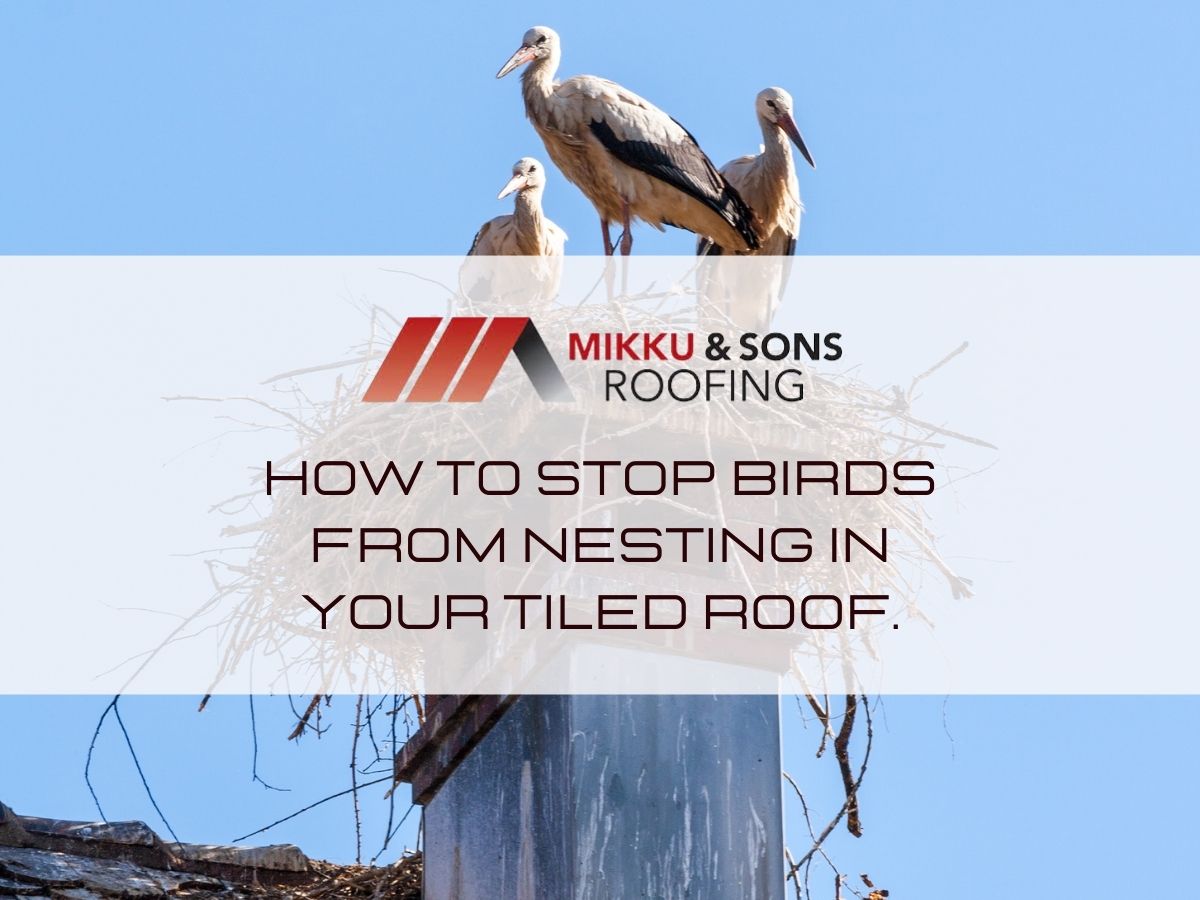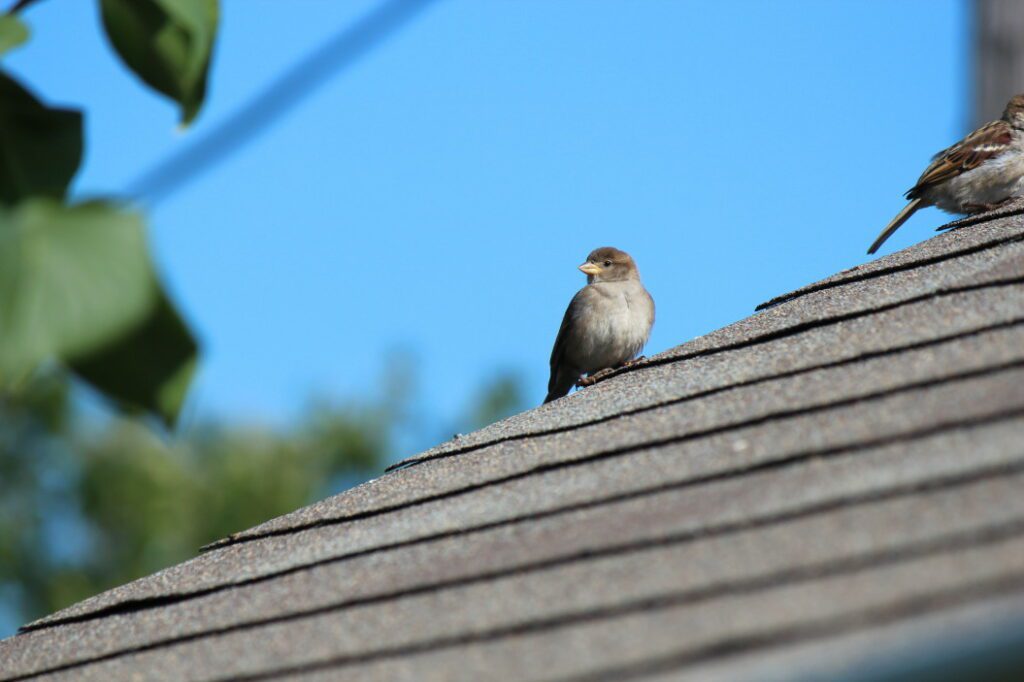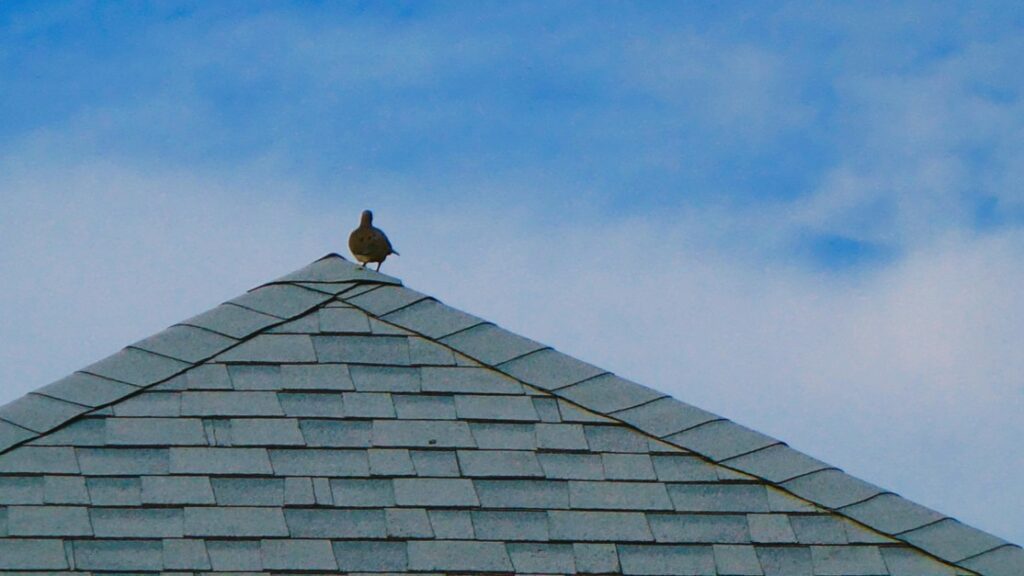

There are relatively few birds that will nest in the roof area or beneath your eaves. As all wild birds are protected by law, proper identification is crucial if the right action is taken.
Wherever you reside in the United States of America or Canada, you'll witness many birds every day. They serve a crucial function in just about every ecosystem globally and exist in hundreds of thousands of forms and sizes.
However, various concerns may emerge when birds come into touch with people.
Many homeowners may confront one difficulty- birds nesting on their roof, especially beneath their roof tiles. This may ruin your property's looks and structure and even threaten your health.
The two most common birds to live in your attic are sparrows and starlings. A house sparrow is a little brown bird that makes a lot of cheeping noises as it enters the roof area via a gap between the roof tiles and the gutter.
The male's appearance is red-brown on the back, grey on top of the head with a black chin. Unlike the male, the female is lighter in color and has no visible markings.
The adult starling is black, green, and purple-glossed, with a pointed yellow beak. Brown with black beak and mask, juveniles are dull. So, if you find yourself noticing several squeaks, crackles, or footsteps, then there may be a few birds nesting in your roof!
Bird of prey is the well-known "town square pigeon, " an out-of-control domestic pigeon. Black, white, grey, or brown are all acceptable colors. The eaves of the structure, on the outside of the building. If there are significant gaps in the roof, they may be able to get in.
When the overhanging roofing felt is ripped, or the soffit boards have begun to deteriorate, swifts are likely to find a dry, secure place inside the roof. They have long, sickle-shaped wings and a sooty brown forked tail.
You won't be able to get them to wander about within your roof since their legs are so short. Constantly kept safe and secure, the nest should not be disturbed.
Old houses with extremely broad chimneys may be a good place for jackdaws and swallows to build their nests, but newer buildings do not have the room. Owls often use the rooftops of rural homes in search of a haven.
Some birds will utilize drain pipes, and if they get stuck in very small or deep tubes, they may perish. In addition to downpipes, bathroom ventilation pipes, and damaged ventilation grilles, sparrows and starlings may also utilize them to build their nests.

It's not uncommon for birds to cause damage to a roof in various ways, including traveling through or nesting beneath your roof tiles. In addition to causing immediate harm to the property, this might have long-term consequences.
When it comes to where they go to the bathroom, birds may be a bit of a nuisance. Put another way; you may rapidly find yourself with a significant issue if birds are nesting beneath your roof tiles or anyplace else in your roof area.
In addition to being unattractive, bird feces includes a high concentration of uric acid, which may eat away at roofing materials over time.
Birds may inflict a variety of damage on your roof tiles. Birds may worsen an existing issue with loose or broken tiles on your roof, especially if they make a nest below them. The nests of birds attract insects, which might swiftly set up shop in your attic and cause structural damage if left unchecked.
You might have a big issue if you don't dissuade birds from using the same nesting site year after year.
After just a few years, a homeowner may find a slew of old, decaying nests with feces, dead chicks, and rotten eggs throughout the yard. These items are not only unpleasant, but they may also pose a health risk.
Birds commonly start nesting in gutters and beneath loose roof tiles or in the hole caused by missing tiles. A lovely clean, high-up area like your rooftop becomes the next best thing when there aren't any trees around.
Guttering also serves as a water source for birds. To prevent your drainage system from overflowing, leaking or water infiltrating your roof area, you should remove any bird nests from your property.
Birds nesting on your roof poses the risk of a fire. Birds' nests are flammable because they're made of grass, dried leaves, twigs, and easily ignited materials.
In addition, birds often build their nests in or near electrical equipment, chimneys, or other ventilation systems because of their warmth. In the case of a fire, smoke would not be able to escape from a residence if the airflow was blocked in this manner.

There are a variety of techniques to protect your roof against nesting birds, each with its own set of advantages and disadvantages.
It's essential to keep in mind that no strategy for keeping birds off your roof is perfect, and each of these alternatives has disadvantages. Ultimately, it's up to you to choose the choice that has the best qualities and the fewest drawbacks.
Birds often build their nests in your roof's eaves. They're an excellent place to perch because of the protection from the weather and the protection from predators.
Protectors for the eaves, eaves closures, and eave guards are used for various items meant to keep birds away. To keep birds out of your attic, you may use them to close any openings in your roofline.
Noise deterrents are a common method of keeping birds away from your property. To prevent birds from nesting, you may place tiny devices on or around your roof, which generate a high-pitched noise that birds find very bothersome.
It's straightforward to install and has long-lasting batteries that enable it to run for an extended period. Sound deterrents are inexpensive and easy to use.
There are several sets available to purchase in a range of sizes. These can be positioned in multiple locations around your house to generate a more extensive range without having to make the noise they produce excessively loud.
| Advantages | Disadvantages |
| A practical method of deterring birds | The sound generated by the noise deterrent can be annoying for neighbors |
| Inexpensive to purchase the devices | If you like birds in your garden, these noises may deter them from entering your backyard. |
| Available in various sizes | |
| Long-lasting batteries and accessible to install |

Many people find decoy birds a bit amusing at first sight, but most bird species will not approach these decoys, even if they seem convincing to humans. Peregrine falcon, red kite, and a variety of owls, among other British birds of prey, are frequent visitors to our countryside. Many bird species
Place the decoy birds on or around your roof - make sure they are as visible from the air as possible by positioning them in open locations, so birds are more likely to spot them. These decoy birds are typically relatively cheap.
Several different decoy birds are available; some are shaped like birds of prey, such as a hawk or a vulture, while others look like kites that may be tethered to a pole and let fly in the wind, providing the appearance of a kite searching for prey.
These decoy birds have a few downsides that you should consider. For example, if they are of a lower quality, they may be unattractive. If bumped or dropped from a height, these specific models may break quickly and appear exceedingly delicate.
Bird spikes are among the most efficient and long-lasting bird deterrents. Instead of making it impossible for birds to land and stand on the surface, they're put on, these accessories, despite their scary-sounding names, make landing and standing more difficult.
This explains why you may see pigeons perched on top of spikes at train stations and the roofs of office buildings throughout major cities. The spikes provide a resting place for the birds, but they are too difficult for them to use for nesting.
Spikes for birds may be bought for various locations on and around your home. Bird spikes can be placed on any surface, including roof verges, ridges, gutters, and porches, and they'll start working right away.
Nesting birds are well-protected by bird guards installed on your chimney.
Although bird spikes pose no harm to birds, they can be unsightly when spread across your roof, as you can imagine. People should avoid areas where these spikes are present since it is dangerous to walk around them.
Filler for the Eaves Comb (Bird Comb) blocks birds and big insects. They cannot get into the gap between Profiled Tiles and the underlay on pitched roofs.
Before the tiles are placed, fix the fascia ventilator with clout nails. There must be an angle in the comb that diverges from the ceiling. The comb should be used to bed the bottom row of tiles.
If you've seen an unusual lot of pigeons on your roof, they probably have a nearby food and water supply. If you're aware of these sources, remove them - it's crucial not to feed pigeons and birds if you intend to get rid of them.
To keep out pesky birds, use shiny, reflecting materials. Birds are deterred from returning to these regions because of the items' reflections in the light.
Using the roof as a nutcracker is a possibility. If they're chasing insects, you're in for an even worse situation than just crows on your roof. A termite examination or searching for other wood-eating insects may be in order.
